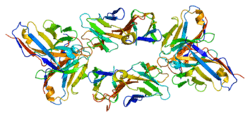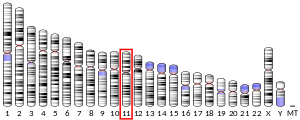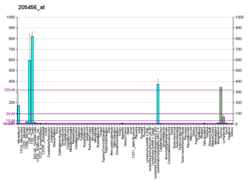T-cell surface glycoprotein CD3 epsilon chain
CD3e molecule, epsilon also known as CD3E is a polypeptide which in humans is encoded by the CD3E gene which resides on chromosome 11.[5][6]
Function
The protein encoded by this gene is the CD3-epsilon polypeptide, which together with CD3-gamma, -delta and -zeta, and the T-cell receptor alpha/beta and gamma/delta heterodimers, forms the T cell receptor-CD3 complex. This complex plays an important role in coupling antigen recognition to several intracellular signal-transduction pathways. The genes encoding the epsilon, gamma and delta polypeptides are located in the same cluster on chromosome 11. The epsilon polypeptide plays an essential role in T-cell development.[7]
Clinical significance
Defects in this gene cause severe immunodeficiency.[8][9] This gene has also been linked to a susceptibility to type I diabetes in women.[10]
Interactions
T-cell surface glycoprotein CD3 epsilon chain has been shown to interact with TOP2B,[11] CD3EAP[12] and NCK2.[13]
References
- GRCh38: Ensembl release 89: ENSG00000198851 - Ensembl, May 2017
- GRCm38: Ensembl release 89: ENSMUSG00000032093 - Ensembl, May 2017
- "Human PubMed Reference:". National Center for Biotechnology Information, U.S. National Library of Medicine.
- "Mouse PubMed Reference:". National Center for Biotechnology Information, U.S. National Library of Medicine.
- Gold DP, Puck JM, Pettey CL, Cho M, Coligan J, Woody JN, Terhorst C (1986). "Isolation of cDNA clones encoding the 20K non-glycosylated polypeptide chain of the human T-cell receptor/T3 complex". Nature. 321 (6068): 431–4. doi:10.1038/321431a0. PMID 3012357.
- Clevers HC, Dunlap S, Wileman TE, Terhorst C (November 1988). "Human CD3-epsilon gene contains three miniexons and is transcribed from a non-TATA promoter". Proceedings of the National Academy of Sciences of the United States of America. 85 (21): 8156–60. doi:10.1073/pnas.85.21.8156. PMC 282386. PMID 3267235.
- "Entrez Gene: CD3E CD3e molecule, epsilon (CD3-TCR complex)".
- Soudais C, de Villartay JP, Le Deist F, Fischer A, Lisowska-Grospierre B (January 1993). "Independent mutations of the human CD3-epsilon gene resulting in a T cell receptor/CD3 complex immunodeficiency". Nature Genetics. 3 (1): 77–81. doi:10.1038/ng0193-77. PMID 8490660.
- de Saint Basile G, Geissmann F, Flori E, Uring-Lambert B, Soudais C, Cavazzana-Calvo M, Durandy A, Jabado N, Fischer A, Le Deist F (November 2004). "Severe combined immunodeficiency caused by deficiency in either the delta or the epsilon subunit of CD3". The Journal of Clinical Investigation. 114 (10): 1512–7. doi:10.1172/JCI22588. PMC 525745. PMID 15546002.
- Wong S, Moore S, Orisio S, Millward A, Demaine AG (January 1991). "Susceptibility to type I diabetes in women is associated with the CD3 epsilon locus on chromosome 11". Clinical and Experimental Immunology. 83 (1): 69–73. doi:10.1111/j.1365-2249.1991.tb05590.x. PMC 1535466. PMID 1671006.
- Nakano H, Yamazaki T, Miyatake S, Nozaki N, Kikuchi A, Saito T (March 1996). "Specific interaction of topoisomerase II beta and the CD3 epsilon chain of the T cell receptor complex". The Journal of Biological Chemistry. 271 (11): 6483–9. doi:10.1074/jbc.271.11.6483. PMID 8626450.
- Yamazaki T, Hamano Y, Tashiro H, Itoh K, Nakano H, Miyatake S, Saito T (June 1999). "CAST, a novel CD3epsilon-binding protein transducing activation signal for interleukin-2 production in T cells". The Journal of Biological Chemistry. 274 (26): 18173–80. doi:10.1074/jbc.274.26.18173. PMID 10373416.
- Gil D, Schamel WW, Montoya M, Sánchez-Madrid F, Alarcón B (June 2002). "Recruitment of Nck by CD3 epsilon reveals a ligand-induced conformational change essential for T cell receptor signaling and synapse formation". Cell. 109 (7): 901–12. doi:10.1016/S0092-8674(02)00799-7. PMID 12110186.
Further reading
- Li CJ (December 2006). "Therapeutic biology: checkpoint pathway activation therapy, HIV Tat, and transkingdom RNA interference". Journal of Cellular Physiology. 209 (3): 695–700. doi:10.1002/jcp.20817. PMID 17001685.
- Thoenes G, Soudais C, le Deist F, Griscelli C, Fischer A, Lisowska-Grospierre B (January 1992). "Structural analysis of low TCR-CD3 complex expression in T cells of an immunodeficient patient". The Journal of Biological Chemistry. 267 (1): 487–93. PMID 1370449.
- Luzzati AL, Giacomini E, Giordani L, Pugliese O, Viora M, Chersi A (August 1992). "The antigen-specific induction of normal human lymphocytes in vitro is down-regulated by a conserved HIV p24 epitope". Immunology Letters. 33 (3): 307–14. doi:10.1016/0165-2478(92)90078-3. PMID 1385321.
- Lanier LL, Chang C, Spits H, Phillips JH (September 1992). "Expression of cytoplasmic CD3 epsilon proteins in activated human adult natural killer (NK) cells and CD3 gamma, delta, epsilon complexes in fetal NK cells. Implications for the relationship of NK and T lymphocytes". Journal of Immunology. 149 (6): 1876–80. PMID 1387664.
- Wong S, Moore S, Orisio S, Millward A, Demaine AG (January 1991). "Susceptibility to type I diabetes in women is associated with the CD3 epsilon locus on chromosome 11". Clinical and Experimental Immunology. 83 (1): 69–73. doi:10.1111/j.1365-2249.1991.tb05590.x. PMC 1535466. PMID 1671006.
- Ruegg CL, Strand M (October 1991). "A synthetic peptide with sequence identity to the transmembrane protein GP41 of HIV-1 inhibits distinct lymphocyte activation pathways dependent on protein kinase C and intracellular calcium influx". Cellular Immunology. 137 (1): 1–13. doi:10.1016/0008-8749(91)90051-C. PMID 1832084.
- Cefai D, Debre P, Kaczorek M, Idziorek T, Autran B, Bismuth G (December 1990). "Human immunodeficiency virus-1 glycoproteins gp120 and gp160 specifically inhibit the CD3/T cell-antigen receptor phosphoinositide transduction pathway". The Journal of Clinical Investigation. 86 (6): 2117–24. doi:10.1172/JCI114950. PMC 329852. PMID 1979339.
- Luzzati AL, Pugliese O, Giacomini E, Giordani L, Quintieri F, Hraba T, Mach O, Krchnák V, Vágner J (1990). "Immunoregulatory effect of a synthetic peptide corresponding to a region of protein p24 of HIV". Folia Biologica. 36 (1): 71–7. PMID 2111780.
- Koning F, Maloy WL, Coligan JE (February 1990). "The implications of subunit interactions for the structure of the T cell receptor-CD3 complex". European Journal of Immunology. 20 (2): 299–305. doi:10.1002/eji.1830200211. PMID 2138083.
- van den Elsen P, Shepley BA, Cho M, Terhorst C (1985). "Isolation and characterization of a cDNA clone encoding the murine homologue of the human 20K T3/T-cell receptor glycoprotein". Nature. 314 (6011): 542–4. doi:10.1038/314542a0. PMID 2859526.
- Gold DP, Puck JM, Pettey CL, Cho M, Coligan J, Woody JN, Terhorst C (1986). "Isolation of cDNA clones encoding the 20K non-glycosylated polypeptide chain of the human T-cell receptor/T3 complex". Nature. 321 (6068): 431–4. doi:10.1038/321431a0. PMID 3012357.
- Clevers HC, Dunlap S, Wileman TE, Terhorst C (November 1988). "Human CD3-epsilon gene contains three miniexons and is transcribed from a non-TATA promoter". Proceedings of the National Academy of Sciences of the United States of America. 85 (21): 8156–60. doi:10.1073/pnas.85.21.8156. PMC 282386. PMID 3267235.
- Gold DP, Clevers H, Alarcon B, Dunlap S, Novotny J, Williams AF, Terhorst C (November 1987). "Evolutionary relationship between the T3 chains of the T-cell receptor complex and the immunoglobulin supergene family". Proceedings of the National Academy of Sciences of the United States of America. 84 (21): 7649–53. doi:10.1073/pnas.84.21.7649. PMC 299357. PMID 3478717.
- DeNofrio D, Radcliff G, Weinhold KJ, Denning SM (August 1995). "CD3 delta and epsilon gene expression in CD3-CD16+ natural killer cell clones derived from thymic precursors". Human Immunology. 43 (4): 283–94. doi:10.1016/0198-8859(95)91034-U. PMID 7499176.
- Kishimoto H, Kubo RT, Yorifuji H, Nakayama T, Asano Y, Tada T (December 1995). "Physical dissociation of the TCR-CD3 complex accompanies receptor ligation". The Journal of Experimental Medicine. 182 (6): 1997–2006. doi:10.1084/jem.182.6.1997. PMC 2192252. PMID 7500045.
- Oravecz T, Norcross MA (October 1993). "Costimulatory properties of the human CD4 molecule: enhancement of CD3-induced T cell activation by human immunodeficiency virus type 1 through viral envelope glycoprotein gp120". AIDS Research and Human Retroviruses. 9 (10): 945–55. doi:10.1089/aid.1993.9.945. PMID 7506554.
- Beecher MS, Baiocchi RA, Linett ML, Krajewski CA, Caligiuri MA (May 1994). "Expression of the zeta protein subunit in CD3- NK effectors derived from human thymus". Cellular Immunology. 155 (2): 508–16. doi:10.1006/cimm.1994.1143. PMID 7514106.
- Luzzati AL, Giacomini E, Giordani L, Viora M, Chersi A, Camponeschi B, Pugliese O (July 1994). "An HIV p24 heptapeptide down-regulates antigen-specific responses in vitro interfering at the level of the T3-Ti complex". Cellular Immunology. 156 (2): 286–95. doi:10.1006/cimm.1994.1175. PMID 7517794.
- Dianzani U, Bragardo M, Buonfiglio D, Redoglia V, Funaro A, Portoles P, Rojo J, Malavasi F, Pileri A (May 1995). "Modulation of CD4 lateral interaction with lymphocyte surface molecules induced by HIV-1 gp120". European Journal of Immunology. 25 (5): 1306–11. doi:10.1002/eji.1830250526. PMID 7539755.
- Müller B, Cooper L, Terhorst C (January 1995). "Interplay between the human TCR/CD3 epsilon and the B-cell antigen receptor associated Ig-beta (B29)". Immunology Letters. 44 (2–3): 97–103. doi:10.1016/0165-2478(94)00199-2. PMID 7541024.
This article incorporates text from the United States National Library of Medicine, which is in the public domain.






